
Feature Article
Preparation of Eggs and Egg Products - Safety First
The food trade lays emphasis on food safety. Members of the trade should know that the consumption of raw or undercooked eggs can lead to Salmonella infection, possibly with severe and even life-threatening health risks to the patients, especially the susceptible populations. From August 2017 to August 2020, 328 Salmonella food poisoning cases related to food premises (involving 995 victims) were referred by the Centre for Health Protection.
To assist the trade in preventing food poisoning caused by Salmonella in eggs and egg products, the Centre for Food Safety (CFS) has published a set of guidelines to provide practical food safety advice on food preparation with eggs. The guidelines are outlined in the following paragraphs.
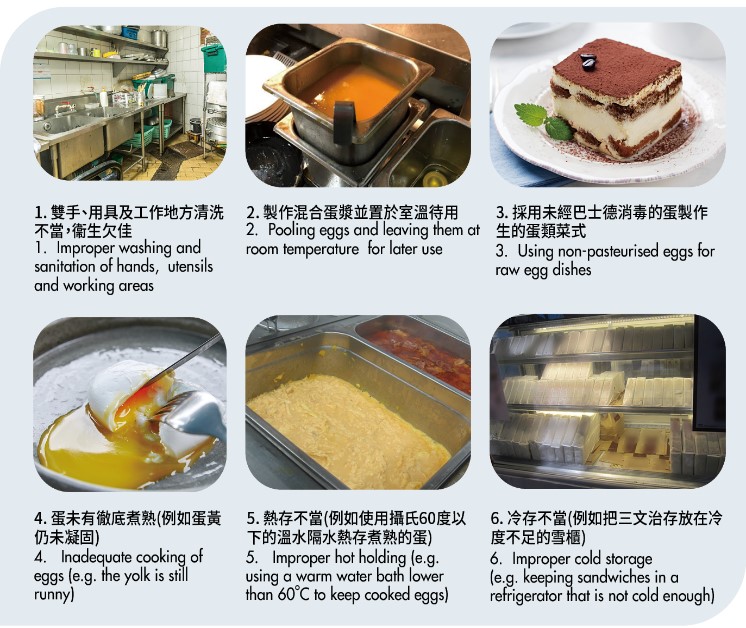
Figure 1: Common high-risk practices of egg preparation in food premises
Choosing Eggs
Choosing safe food ingredients is the first step to ensure food safety. Food businesses should purchase eggs from reliable sources and only accept eggs that are clean and without cracks or leakage. For dishes prepared with lightly cooked or uncooked eggs (e.g. soft-scrambled eggs or tiramisu), it is advisable to use pasteurised eggs/egg products or dried egg powder. Pasteurisation is the process of applying low heat to kill pathogens and deactivate spoilage enzymes.
In some countries, certain shell eggs are produced under certification systems with measures taken at the farm level to reduce the risk of Salmonella contamination. While these eggs are claimed to be safe for raw consumption, they have been reported to be tested positive for Salmonella and occasionally contributing to foodborne disease outbreaks overseas. Therefore, pasteurised eggs/egg products are still a much safer choice if undercooked eggs are used in food preparation.
Storing and Handling Raw Eggs
Shell eggs should be stored in a cool and dry place (preferably in the refrigerator) and used on a first-in-first-out basis. Improper handling of raw eggs can result in cross-contamination and food poisoning. Food handlers should wash their hands thoroughly before and after handling eggs. They should also clean and sanitise all utensils and other food contact surfaces such as whisks, bowls and working benches every time before handling eggs and egg products.
Washing shell eggs is unnecessary as this will facilitate penetration of bacteria into the egg through pores on the shell. To separate the yolk from the white, a clean egg separator should be used instead of the egg shell, as the shell may contain traces of Salmonella on the surface.
Pooling Eggs Is a High-risk Practice When Preparing Egg Dishes
Pooling refers to the practice of breaking a number of eggs into a container and using the combined eggs to make multiple servings of egg dishes or as an ingredient for multiple recipes. Pooling of eggs is a common practice in some restaurants to save time and control the portion size. However, if one or more eggs are infected, the whole pool of eggs will be contaminated. If people consume dishes prepared with the contaminated pool of eggs without thorough cooking, they will be at risk of food poisoning. Pooled eggs that are contaminated can also become a reservoir for Salmonella in restaurants as they may contaminate the utensils or other foods.
Restaurants should break enough eggs for food preparation only upon receiving orders from consumers. Pooled eggs prepared for later use should be kept in covered containers and placed in the refrigerator. Only the amount needed should be taken out for use. All pooled eggs should be used within the day of pooling. Topping up with new eggs is not suggested. A pool of liquid eggs is more likely to harbour bacteria. It should be cooked thoroughly and should not be used for making raw or lightly cooked dishes.
Cook Eggs Thoroughly and Keep Them at a Safe Temperature
The best way to eliminate harmful bacteria is to cook eggs thoroughly until the core temperature reaches 75°C or the yolks are firm. Improper holding temperature of egg dishes is a common cause of local food poisoning outbreaks. If egg dishes are not consumed immediately after preparation, hot foods such as soft-scrambled eggs should always be served or kept at above 60°C, and cold foods such as sandwiches and desserts should be stored at 4°C or below.
Mascot ON in Lesson
Is Air Frying a "Lesser Evil" Than Deep Frying?
The air fryer, introduced over a decade ago, has become an increasingly popular kitchen appliance in Hong Kong in recent years. With its compact size and versatility for preparing a wide variety of dishes, the air fryer appeals to many local households. It is touted as using less oil than deep frying and cooking more quickly than the convection oven, which fits in with the lifestyle and settings of small families.
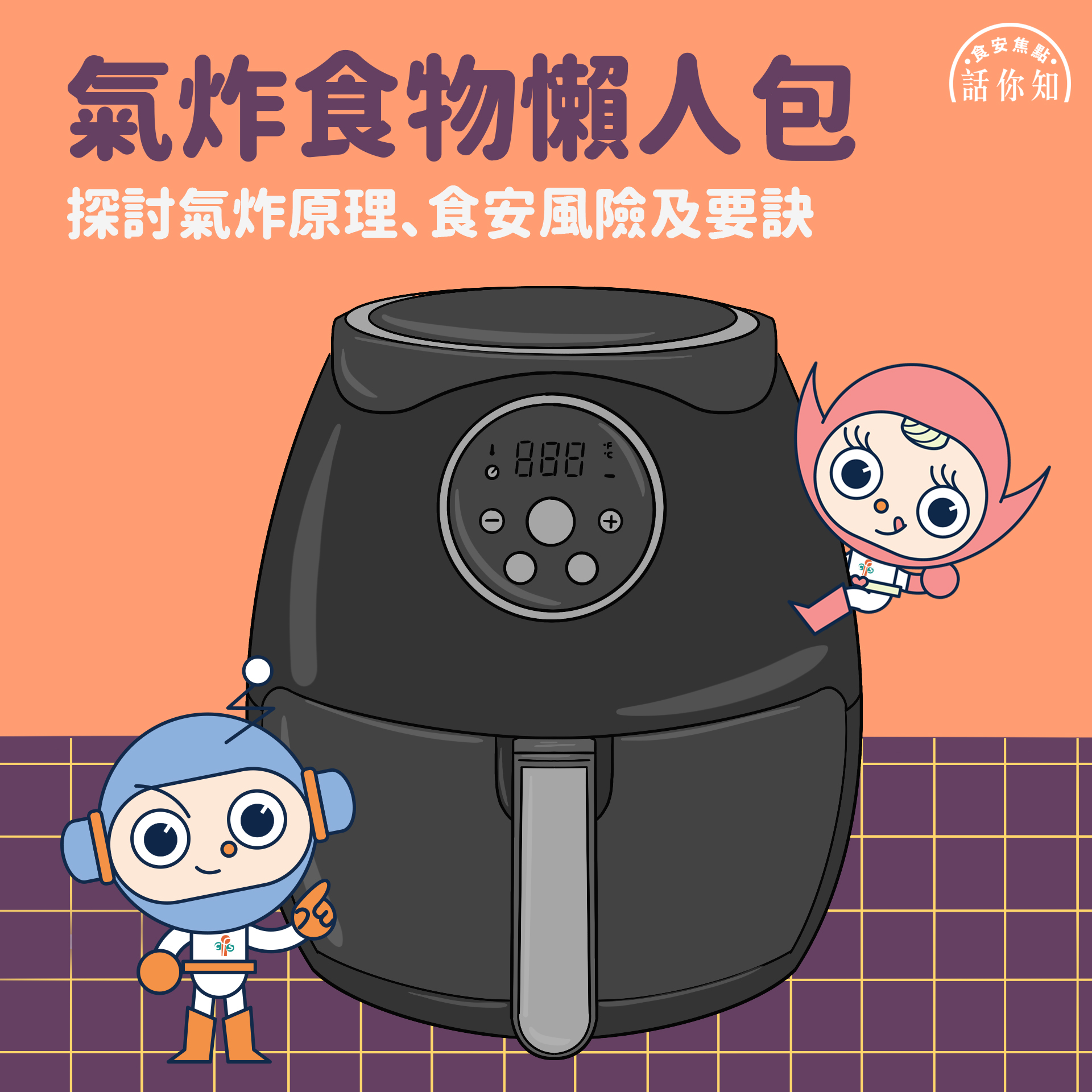
In this issue, we will introduce the principles of air frying and discuss its pros and cons in terms of food safety and the precautions to take for preparing food with an air fryer.
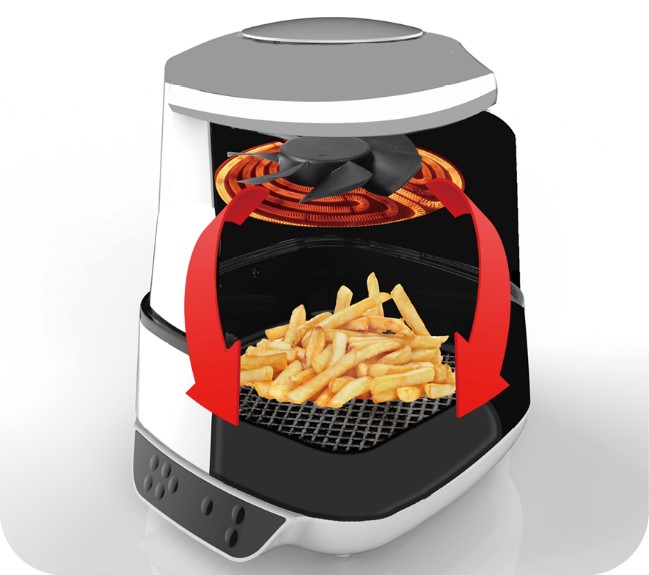
Figure 1: The basic operating principles of air fryers ― There is a fan next to the heating element to keep hot air in rapid circulation. Food is kept close to the heat source and oil drips are collected beneath the perforated basket.
How Does an Air Fryer Work?
Albeit its name, an air fryer is actually a small, countertop convection oven. Like a convection oven, it uses a heating element to heat food with hot air circulation aided by a built-in fan. Food is placed close to the heat source in the air fryer and blown by hot air (up to about 200°C) at a high speed. The food is cooked in a perforated basket, which facilitates hot air to move around it. The circulating air will make the food surface crisp without drying out the inside. This cooking process mimics the result of deep frying with little or even no oil applied. Since food is cooked by circulation of hot air in a small, confined space, air fryers will work best when the food is cut into small bits without the pieces overlapping each other.
Is Air Frying a Healthier Way to Cook?
To answer this question, we need to take different aspects of food safety and nutrition into consideration.
Reduced Amount of Fat
As the medium of heat transfer is air rather than oil, oil is often sparingly applied during air frying to enhance the food texture. Besides, any fat-containing juice drained from the meat will be separately collected beneath the perforated basket.
While air frying can reduce a significant amount of total fat in food, it is a kind of dry-heat cooking at high temperatures. It is similar to baking where high-temperature cooking can easily give rise to chemical contaminants like acrylamide and polycyclic aromatic hydrocarbons. The public should be careful with what they choose to eat and maintain a balanced diet with plenty of fruits and vegetables to keep the intake of fat and salt in check.
Formation of Acrylamide During Cooking
Acrylamide is a chemical contaminant resulted from high-temperature cooking. It can probably cause cancers in humans. Acrylamide can be formed in carbohydrate-rich food during air frying at 120℃ or above by the reaction of free asparagine (an amino acid) and reducing sugars like glucose and fructose in the food. A probable human carcinogen with genotoxicity, acrylamide has no safe level for consumption and its level should be kept as low as reasonably possible.
It remains inconclusive whether air frying will produce less acrylamide than deep frying. Although a number of studies find that air-fried potatoes contain less acrylamide than comparable deep-fried ones, a few report no significant differences in the amount of acrylamide formed in both cooking processes. Other factors, including the composition of potatoes or starches used, the surface area of food and the cooking time and temperature, also add to the complexity of acrylamide formation. As a rule of thumb, it is safer to “go for gold” in air frying, that is, to aim for a golden brown or lighter colour when preparing starchy foods like potato, taro and bread and do not overcook them.
Cook Thoroughly and Don't Overload Your Air fryer
We should make sure that food (especially bigger chunks of food) is cooked thoroughly. Moreover, food should be cooked in batches to avoid overloading the air fryer. Attention should be paid to some parts of food that can easily become burnt to avoid the formation of hazardous chemical contaminants. Turn the food occasionally to ensure even cooking and prevent the food from getting burnt. In short, food should be cooked till it is well done but not burnt.
Spot Check
How To Avoid Cross-contamination of Food?
In September 2020, 19 people from 7 groups experienced gastrointestinal symptoms after consuming baked lobsters with E-fu noodles purchased from a restaurant in Tuen Mun. Vibrio parahaemolyticus, a bacterium that lives naturally in sea water, was the causative agent of the food poisoning cases. Investigation revealed that food handlers of the restaurant wore the same pair of gloves in handling raw seafood and cooked ingredients and dried their hands with the towel used for cleaning the work table. Moreover, the same work table was used for handling both raw seafood and cooked food. Cross-contamination was therefore the most likely contributing factor to these food poisoning outbreaks. In fact, cross-contamination is one of the often overlooked but preventable causes of food poisoning.
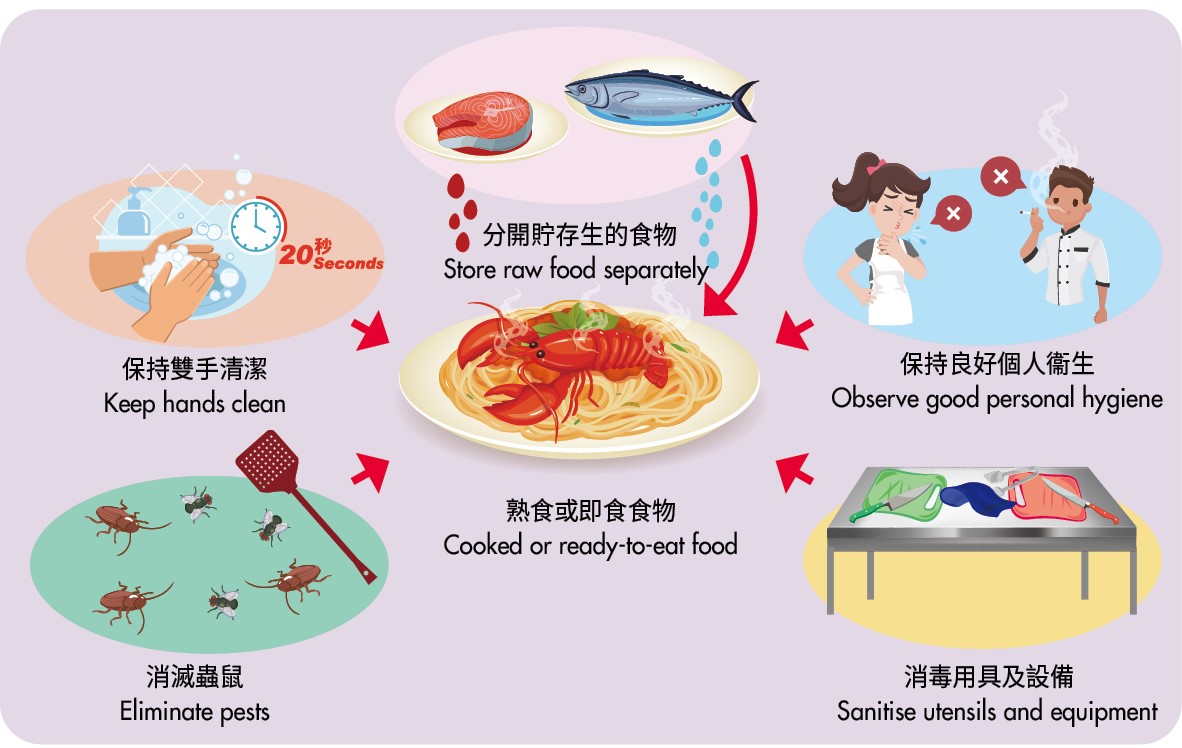
Figure 1: Ways to avoid cross-contamination
Cross-contamination Is a Means of Transmission of Food Poisoning Organisms
Cross-contamination refers to the transfer of microorganisms from one vehicle, such as food (especially raw food), utensils and hands of food handlers, to another food. There are two ways where cross-contamination may occur. On one hand, bacteria can be transferred directly when one food touches or drips onto another. On the other hand, bacteria can be transferred indirectly from contaminated hands, pest droppings, food preparation equipment and utensils, worktops or even splashes to food.
Aggravating Factors
Many food premises in Hong Kong have small kitchens. Tight food preparation areas, coupled with the provision of a vast variety of dishes and an even higher output during rush hours, may lead to slippage in food safety practices during food preparation. This can aggravate the risk of cross-contamination of ready-to-eat food. Despite different constraints, operators of food premises can follow some basic and effective steps to avoid cross-contamination. As the risk of cross-contamination also exists in a domestic environment, the same basic steps should be observed to prevent cross-contamination of food.
Basic Steps to Avoid Cross-contamination
During food preparation, we should always wash our hands thoroughly, especially after touching raw food or its packaging and right before handling cooked/ready-to-eat food. Wash hands with liquid soap and water and rub them for at least 20 seconds. Then rinse hands with water and dry them with a disposable paper towel. Wear disposable gloves when handling read-to-eat food. Gloves should be changed when damaged or soiled, such as after touching raw food. Bear in mind that wearing disposable gloves is no substitute for proper hand hygiene.
Effective cleaning and disinfection of food preparation equipment and cooking utensils is equally important. Work surfaces must be thoroughly cleaned and disinfected before being used for cooked/ready-to-eat food. Wash utensils and worktops with hot water and detergent, especially after preparing raw food.
Furthermore, raw food and cooked/ready-to-eat food in the same refrigerator should be stored separately in covered containers to avoid contact between foods. Store raw food below cooked/ready-to-eat food in the refrigerator to prevent cross-contamination through drippings. To guard against pest contamination, cooked/ready-to-eat food should be stored out of reach from pests.
Key Points to Note
-
Cross-contamination is a common and important contributing factor to food poisoning.
- Cross-contamination can occur directly via raw food touching or dripping onto cooked/ready-to-eat food, or indirectly via contaminated hands, pests, work surfaces, food preparation equipment and utensils.
-
Cross-contamination is preventable with the application of some basic hygienic practices, whether in food premises or a domestic environment.
Advice to Trade
- The management should provide training for food handlers so that they can fully understand the risk of cross-contamination in handling raw food and observe good personal hygiene to prevent cross-contamination.
- Review the food preparation work flow to identify the risk of cross-contamination and design a food safety plan to eliminate the risk.
- Always adhere to the "5 Keys to Food Safety" (especially the two keys summed up as "Clean" and "Separate") to safeguard against cross-contamination during food preparation.
Safe Kitchen/Trade Talks/Food Safety Guidelines
Introduction to "Safe Kitchen" Scheme
To facilitate trade members in adopting the "5 Keys to Food Safety" and good hygienic practices to enhance food safety in daily operation, the CFS has integrated the existing channels of risk communication to launch a new platform, namely "Safe Kitchen", to communicate with the trade. The platform serves to provide food safety information of greater practical importance to meet the operational needs of catering outlets.
The "Safe Kitchen" platform disseminates the most updated food safety information (including food safety guidelines and relevant legislative amendments) to the trade through a host of channels including WhatsApp, emails and dedicated websites. In response to food poisoning outbreaks in restaurants, the platform will also issue food alerts to remind the trade of the points to note in preventing future occurrences so that the risk of food poisoning can be minimised.
New dedicated websites and risk information exchange platforms will be rolled out under the "Safe Kitchen" Scheme. In addition, training materials tailor-made for the trade and different workshops for kitchen staff will be provided to enhance food safety and hygiene awareness among food handlers.
Members of the trade are welcome to scan the following QR code to download the registration form for the "Safe Kitchen" Scheme in order to receive the latest food safety information in a timely manner.
"Safe Kitchen" Trade Talks
The CFS will organise a series of talks from April to November 2021. One of the topics will be "raw and cold food", which is set to remind the public (especially the susceptible populations) of the potential risks of consuming "raw and cold food" and advise the trade to take measures to enable consumers to make informed choices in ordering such food items. The other topics will include the Hazard Analysis and Critical Control Point (HACCP) System, the threats of antimicrobial resistance, the "5 Keys to Food Safety" and nutrition labelling. It is hoped that with a better understanding of food safety and a healthy diet, the public can choose healthier food and eat with ease of mind.
Food Safety Guidelines
(1) Food Safety Advice for Producing Siu-mei
Siu-mei is a local delicacy with distinctive flavours. However, it is subject to cross-contamination if not properly handled during packaging and delivery. The CFS has published the booklet "Food Safety Advice for Producing Siu-mei" to discuss the potential hazards and risks involved in the production and delivery of siu-mei and provide advice on the appropriate control measures. Members of the trade are welcome to browse the booklet by visiting the following webpage:

(2) Trade Guidelines on the Use of Deep-frying Oil
Deep-frying is a commonly used cooking method, but deteriorated deep-frying oil can result in health risks. The CFS has issued the "Trade Guidelines on the Use of Deep-frying Oil" to introduce the quality indicators of deep-frying oil and give recommendations on the use of deep-frying oil. The guidelines are available at the following webpage for reference by the trade:
https://www.cfs.gov.hk/english/food_leg/files/guidelines_use_of_deep_frying_oil_e.pdf

News on CFS
(1) Food Safety App will Cease Operation with Effect from Noon on 31 March 2021
In order that resources for risk communication are allocated more efficiently, the Food Safety App of the CFS will cease operation with effect from noon on 31 March 2021. We apologise for any inconvenience this may cause.
The CFS will continue to disseminate food safety information timely and effectively to the public and the food trade in an interactive and diversified manner through different channels. Please visit the CFS website (www.cfs.gov.hk) or follow our Facebook page (www.facebook.com/cfs.hk) and Instagram page (www.instagram.com/cfs.hk/) to learn about and share updated information on food safety.
(2) "FoodSafe Movie Channel" - A New Online Video Campaign on Food Safety

The CFS has recently launched the "FoodSafe Movie Channel", a brand new online video campaign with the CFS mascots, ON and MUI, sharing food safety topics with the public by hinting at local movies in a humorous manner. Featuring parodies of some well-known movie scenes, the channel is a fun approach for members of the public to gain practical food safety information towards maintaining a safer and healthier diet.
The "FoodSafe Movie Channel", premiered on the CFS YouTube Channel on 7 January 2021, is also broadcast on the CFS Facebook and Instagram pages. We look forward to your support. Please feel free to share these videos with your family and friends.
 |
 |
 |
| CFS YouTube Channel | CFS Facebook Page | CFS Instagram Page |
(3) Completion of Public Consultation on Proposed Amendments to Harmful Substances in Food Regulations (Cap. 132AF)
The Government has conducted a three-month public consultation to strengthen and update the Harmful Substances in Food Regulations (Cap. 132AF) for better protection of public health. The exercise was concluded on 15 March 2021.
During the consultation period, members of the public, relevant sectors of the trade and other stakeholders were invited to express their views on the proposed amendments to the Regulations at consultation forums and meetings. The major proposals included strengthening the regulatory control of mycotoxins in food, setting the maximum levels for five other harmful substances (benzo[a]pyrene, glycidyl fatty acid esters, melamine, 3-monochloropropane-1,2-diol and erucic acid) in edible fats and oils, condiments and formula products intended for infants, and regarding partially hydrogenated oils (i.e. the main source of industrially-produced trans fatty acids) as a prohibited substance in food.
A grace period of 18 months following the publication of the amended Regulations in the Gazette was also proposed to allow sufficient time for the trade to prepare for the updated food safety standards. Please visit the following website for details:
www.cfs.gov.hk/harmfulsubstance

Ask Our Mascots
Do Not Judge an Egg by the Shell Colour

Mandy: Hello, Mascot ON. Are eggs with darker shells more nutritious?
ON: Many people choose eggs with great care. They not only check the shell for cracks and stains but also judge the nutritional value of an egg by its shell colour. Is this an accurate method? Let’s take a closer look.
The colour of an eggshell is largely determined by the chicken breed. Apart from genetic factors, the age of the hen also affects the shell colour. For example, hens that lay brown eggs will produce eggs that are larger and lighter in colour as they grow older. Some people may think that brown eggs are more natural and nutritious than white eggs. Actually, brown-shelled and white-shelled eggs are similar in nutritional value. It is the diets and the habitats of hens which have a greater influence on the nutrition of eggs.
Mandy: Why are egg yolks in different colours then?
ON: The colour of an egg yolk is affected by different factors, such as the pigments in chicken feeds. If hens are given feeds rich in carotenoids, like corns or carrots, they will lay eggs with yolks of a dark orange colour due to the pigments naturally present in these plants.
Mandy: I see. Thank you, ON!
Knowledge Improvement Quiz
- Which of the following statements about trans fats is incorrect?
- Hydrogenated vegetable oils are a major dietary source of trans fats.
- Trans fats are required to be listed as a nutrient on the nutrition label.
- Trans fats are a type of saturated fats.
- There is evidence that trans fats raise low-density lipoprotein cholesterol (so-called “bad” cholesterol) levels and lower high-density lipoprotein cholesterol (so-called “good” cholesterol) levels in blood, which is associated with an increased risk of coronary heart disease and other vascular diseases.
- For prepackaged foods labelled with the claim “low sodium”, how many milligrams (mg) of sodium are allowed per 100 grams (g) of food?
- 120mg
- 140mg
- 200mg
- Which of the following is not a correct way of using disposable gloves?
- Wash hands thoroughly before wearing, after removing and when replacing gloves.
- After handling raw food, there is no need to replace gloves before processing cooked food.
- Gloves should be replaced immediately if soiled.
Diary of Mascot ON
Food Fact Checker: Are All Bolete Mushrooms Safe to Eat?
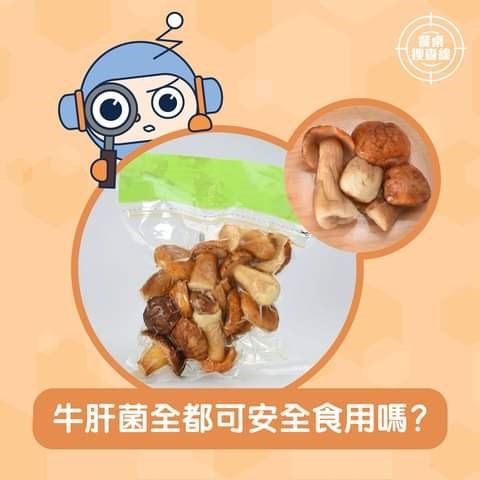
Recently, there was a food poisoning case suspected to be caused by the consumption of bolete mushrooms. As the CFS mascot, I joined the CFS staff to conduct an investigation in the shop concerned and take samples for testing to find out the cause of the incident. As remarked by fungi experts after assessing the samples, the food poisoning case was caused by consumption of boletes containing inedible/poisonous mushrooms.
We should note that bolete mushrooms come in different species. Not all of them are edible and some are poisonous. If people harvest bolete mushrooms from the wild for consumption, they may inadvertently mix edible boletes with other poisonous mushrooms and become poisoned after consuming the mushrooms, which often results in acute cases with the development of gastrointestinal symptoms like nausea, vomiting and abdominal pain shortly after ingestion. Depending on the types of poisonous mushrooms, the affected persons may have other symptoms such as extreme thirst, excessive sweating, coma, hallucination, euphoria and liver damage.
Edible bolete mushrooms for sale should be harvested by trained or experienced workers, or sourced from reputable suppliers. It is also important to ensure that suppliers have measures in place to prevent edible boletes from mixing with poisonous mushrooms.
Consumers should buy mushroom products from reputable and reliable shops to ensure that they are safe for consumption. Do not pick and eat wild mushrooms. Avoid purchasing mushroom products that are suspected to contain unknown species of mushrooms, or when the mushrooms appear unhygienic (e.g. with growing substrates on the surface) or show signs of spoilage (e.g. coloured spots, abnormal smell, slime), or when the package has lots of dust or crumbled pieces in it.
Last but not least, seek medical treatment immediately if mushroom poisoning is suspected.

